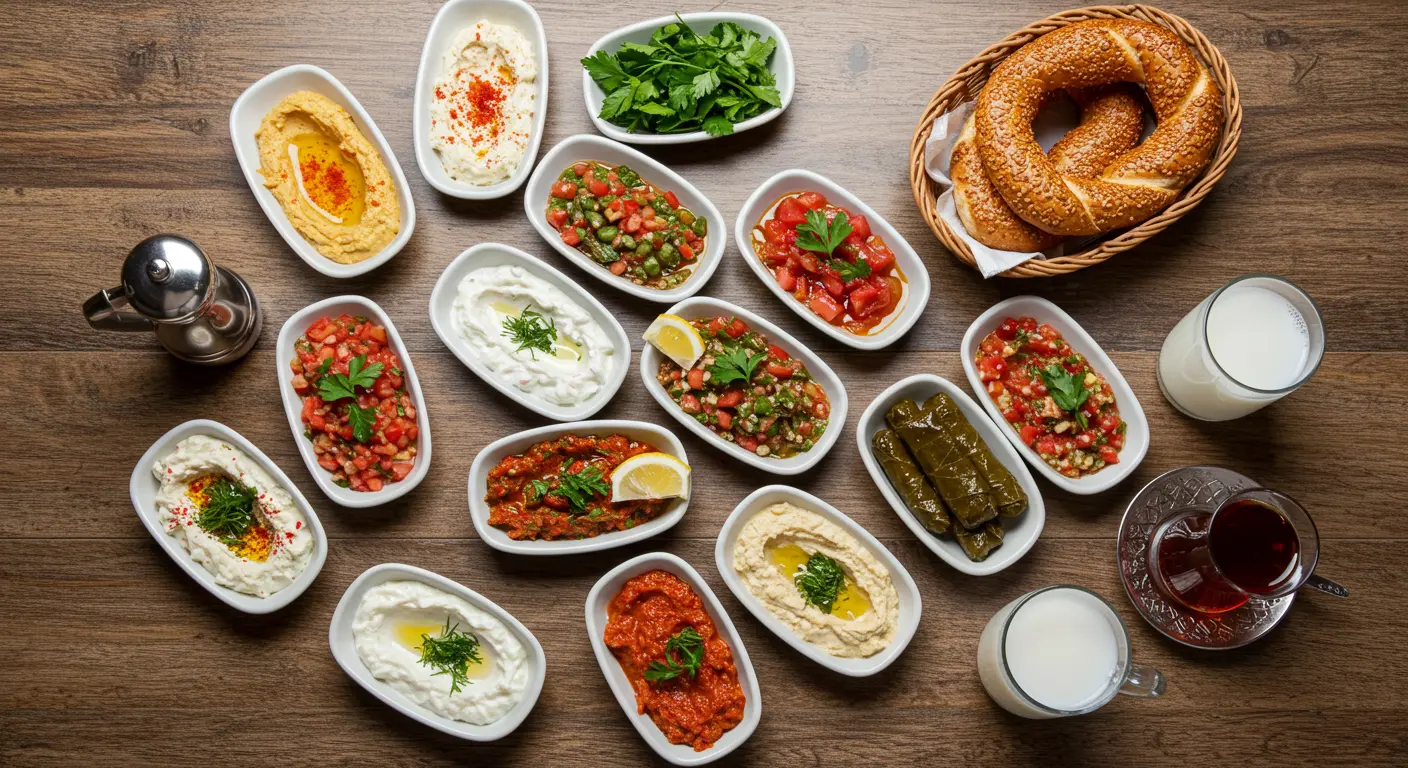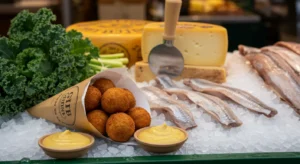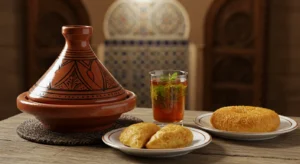Table of Contents
A Beginner’s Guide to the Irresistible World of Turkish Food
That first unforgettable bite. Maybe it’s the smoky scent of sizzling meat from a corner grill, the flaky, buttery layers of a pastry you can’t pronounce yet, or the surprising cool tang of a yogurt-based drink. Turkish food has a way of grabbing you, not just with its flavors, but with its sheer, unapologetic joy. It’s a cuisine that feels both ancient and vibrantly alive, a central pillar of daily life from the bustling streets of Istanbul to the quiet villages dotting the Aegean coast.
If you’ve ever stared at a menu filled with names like çöp şiş, içli köfte, or hünkar beğendi and felt a little lost, you’re in the right place. This guide is your friendly introduction. We’re not just going to list dishes; we’re going to unpack the heart and soul of Turkish cooking. You’ll learn what makes it unique, the must-try classics that will make you feel like an insider, and the simple customs that will enhance your dining experience, whether you’re planning a trip or just visiting a local Turkish restaurant.
More Than Just Kebabs: The Heartbeat of Turkish Cuisine
It’s the first thing that comes to mind, right? But Turkish food is a universe away from being just meat on a stick. The foundation of this rich culinary tradition is its incredible diversity, shaped by a geography that straddles Europe and Asia and a history that was the center of the vast Ottoman Empire. Think of the Ottomans as the original food fusionists—they brought together ingredients and techniques from the Middle East, the Balkans, Central Asia, and the Mediterranean.
This created a cuisine built on a few key principles:
- Freshness is Non-Negotiable: Turks are passionate about seasonal, fresh produce. A tomato in summer tastes like a completely different fruit than one in winter. Markets (pazar) are a weekly ritual, and dishes change with what’s available.
- The Holy Trinity of Flavors: Many dishes achieve their deep, complex taste through a base of sautéed onions, a generous spoonful of tomato or red pepper paste (salça), and a final swirl of high-quality olive oil or butter.
- Yogurt is a Way of Life: It’s a sauce, a drink (ayran), a soup, and a dessert. Its cool, tangy presence balances spicy and oily foods perfectly.
- The Art of the Vegetable: Turkish cuisine is a vegetarian’s dream. Vegetables are stuffed (dolma), simmered in olive oil (zeytinyağlılar), turned into fritters (mücver), and grilled to perfection.
Your Turkish Food Bucket List: Where to Begin
Alright, let’s get to the good stuff. Here’s a handpicked list of dishes that form the perfect introduction. Don’t worry about mastering the pronunciation immediately; a point and a smile work just fine!
The Stars of the Show: Meze & Small Plates
Meze aren’t just appetizers; they’re a social event. A table crowded with small plates encourages sharing, conversation, and a slow, enjoyable start to a meal.
- Haydari: A thick, garlicky yogurt dip strained for hours, mixed with dill, and often topped with walnuts. It’s cool, creamy, and addictive with fresh bread.
- Ezme: A fiery, finely chopped salad of tomatoes, peppers, onions, and a hefty dose of spices. It’s a flavor explosion that wakes up your palate.
- Dolma & Sarma: The difference? Dolma means “stuffed” and often refers to vegetables like peppers, tomatoes, or zucchini filled with a rice-and-herb mixture. Sarma means “wrapped,” and the most famous are yaprak sarma—tender grape leaves wrapped around the same delicious filling.
Main Events: Beyond the Kebab
Yes, kebabs are wonderful, but let’s look at the classics.
- The Kebab Spectrum: It’s a family, not a single dish.
- Şiş Kebab: Tender cubes of marinated lamb or chicken grilled on a skewer. Simple and perfect.
- Döner Kebab: The famous vertical rotisserie meat, shaved thin and served in bread as a quick sandwich or on a plate with rice.
- Adana Kebab: A long, hand-minced lamb kebab mixed with red pepper flakes, giving it a signature kick. Named for the city of Adana.
- Köfte: These are Turkish meatballs, but they’re often more like seasoned, oblong patties of ground meat. They can be grilled, pan-fried, or simmered in a sauce. İzmir Köfte, simmered in a tomato-pepper sauce, is a beloved comfort food.
- The Sultan’s Delight: Hünkar Beğendi: This dish’s name translates to “the Sultan was pleased,” and you will be too. It features tender lamb stew served over a sublime, smoky eggplant purée that’s enriched with béchamel sauce. It’s a masterpiece.
The Unsung Heroes: Street Food & Comfort Food
This is where you’ll see the real rhythm of Turkish life.
- Simit: The ultimate Turkish street food. It’s a circular bread, encrusted with sesame seeds, that’s crispy on the outside and chewy on the inside. Grab one from a street vendor for breakfast with a cup of tea.
- Balık Ekmek: The “fish bread” sandwich sold from boats along the Istanbul waterfront. A freshly grilled mackerel fillet stuffed into a half-loaf of bread with onions and lettuce—it’s simple, messy, and unforgettable.
- Lahmacun: Often called “Turkish pizza,” but that doesn’t do it justice. It’s a paper-thin crust topped with a sparing layer of minced meat, vegetables, and herbs. You squeeze lemon juice over it, add some parsley, roll it up, and eat it with your hands.
- Pide: This is closer to what many think of as pizza. A boat-shaped flatbread topped with cheese, ground meat, eggs, or spinach. A whole one is a meal in itself.
A Sweet Ending: The World of Turkish Desserts
Turkish desserts are in a league of their own, balancing syrup, nuts, and dairy in incredible ways.
- Baklava: You know the name, but the real thing is a revelation. Layers of paper-thin pastry (yufka), filled with pistachios or walnuts, and soaked in a sweet syrup. The best is buttery, flaky, and not cloyingly sweet.
- Fırın Sütlaç (Baked Rice Pudding): The Turkish version has a delicate flavor, often scented with vanilla, and is baked to create a caramelized top that contrasts beautifully with the cool, creamy pudding beneath.
- Künefe: A showstopper. Shredded pastry is filled with stretchy, unsalted cheese, baked until golden, and then drenched in syrup. It’s served piping hot, often with a sprinkle of pistachios and a side of clotted cream (kaymak).
How to Eat Like a Local: A Few Simple Tips
Understanding the customs will make your experience ten times richer.
- Turkish Tea (Çay) is the Social Glue: Served in distinctive tulip-shaped glasses, çay is offered constantly—as a welcome, during business, after meals. It’s polite to accept at least one glass.
- Bread is Sacred: It’s on almost every table and is used to scoop up food. It’s considered wasteful to leave bits of bread on your plate.
- Embrace the Yogurt Drink: Ayran: This salty yogurt drink is the national beverage and the perfect accompaniment to grilled meats and oily dishes. It’s surprisingly refreshing.
- Breakfast is a Feast (Kahvaltı): Don’t expect a quick bowl of cereal. A Turkish breakfast is a spread of cheeses, olives, tomatoes, cucumbers, jams, honey, eggs, and sausages (sucuk). It’s an event meant to be lingered over.
For an incredible deep dive into the history and cultural significance of these dishes, the Turkish Cultural Foundation has an extensive food portal that is an authoritative resource for anyone wanting to learn more.
Frequently Asked Questions (FAQs)
Q: Is Turkish food very spicy?
A: Generally, no. While there are spicy dishes like ezme or Adana kebab, most Turkish food relies on the harmonious blending of herbs and spices like mint, paprika, cumin, and sumac for flavor, not just heat. You can almost always control the spice level.
Q: What are the best options for vegetarians?
A: Turkish cuisine is a paradise for vegetarians! You have a huge array of dishes based on legumes (like lentil soup), stuffed vegetables (dolma), olive-oil-based vegetable plates (zeytinyağlılar), bean stews, and cheese-filled pastries like börek.
Q: What is the one dish I absolutely must try?
A: That’s like choosing a favorite child! But if forced to pick one that encapsulates the spirit of Turkish home cooking, it might be İmam Bayıldı (“the Imam fainted”). It’s an eggplant dish braised in olive oil with tomatoes and onions—so named because the story goes the Imam fainted from joy at its taste. It’s that good.
Q: How important is meat in Turkish cuisine?
A: Meat, especially lamb and chicken, is central to many celebratory and restaurant dishes. However, the everyday home cooking of Turkey is heavily vegetable-focused, thanks to the principles of Mediterranean and Aegean cooking. There’s a wonderful balance.
Your Flavor Adventure Awaits
Turkish food is more than sustenance; it’s an expression of history, geography, and profound hospitality. It’s about the shared plate, the clinking çay glasses, and the joy of discovering a new favorite flavor. So, take this guide, find a well-reviewed Turkish restaurant in your city, or better yet, start dreaming of a trip to Istanbul. Be bold, ask questions, and let your taste buds lead the way. Afiyet olsun! (That’s “bon appétit,” and you’ll be hearing it a lot.)




